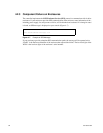Troubleshooting
007-5510-002 93
4.2.2.4 Changing the Rate of Rebuild
The commands TIER DELAY and TIER EXTENT control the percentage of processor time allocated to
rebuild compared to I/O handling. Rebuild is done in steps. DELAY will control the amount of wait time
before rebuilding the next chunk of data. EXTENT determines the size of data used to rebuild.
To increase the rate of rebuild, reduce the DELAY value. (See “Resources Allocation” on page 66.) We
recommend that you use the default DELAY and EXTENT settings unless you have a specific need to
change them.
4.2.2.5 Interrupting the Rebuild Operation
To abort the rebuild, enter tier stop to stop all current rebuild operations.
4.2.2.6 Multiple Drive and Channel Failures
If multiple drives on the same drive channel fail simultaneously, the problem may be a channel failure
rather than a series of drive failures. For example, if drives 1D, 2D, and 3D fail at the same time, the
problem may be in Channel D rather than in the drives. If the drives fail as the result of a channel failure,
data on the drives may not be lost. Any single channel failure can be recovered.
Before you replace any drives:
1. Use the TIER command to check the current disk status and see if the drives failed are all on the
same channel.
2. Use the DISK command to check the status of the channel.
The Recovery steps are:
1. Contact SGI technical support to determine the cause of error and what steps may need to be taken
to recover form the error.
2. Isolate the cause of channel failure (for example, loose cable connections).
3. Rebuild all the drives on that channel individually by issuing the command:
disk rebuild=<tier><channel>
For example, disk rebuild=1d, disk rebuild=2d, disk rebuild=3d.
Several rebuild operations are processed at the same time. The other rebuild jobs are queued up and
processed in the same order as they were entered.


















